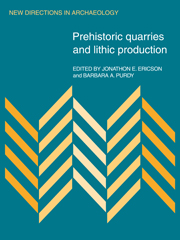Book contents
- Frontmatter
- Contents
- List of contributors
- Dedication
- Part 1 Introduction
- Part 2 Procurement, production, and exchange
- Part 3 Technology and techniques
- 10 Jigsaw: reconstructive lithic technology
- 11 Quarry studies: technological and chronological significance
- 12 Characterization of selected soapstone sources in southern New England
- 13 Reconstructing Corbiac: the context of manufacturing at an Upper Paleolithic quarry
- Index
10 - Jigsaw: reconstructive lithic technology
Published online by Cambridge University Press: 04 August 2010
- Frontmatter
- Contents
- List of contributors
- Dedication
- Part 1 Introduction
- Part 2 Procurement, production, and exchange
- Part 3 Technology and techniques
- 10 Jigsaw: reconstructive lithic technology
- 11 Quarry studies: technological and chronological significance
- 12 Characterization of selected soapstone sources in southern New England
- 13 Reconstructing Corbiac: the context of manufacturing at an Upper Paleolithic quarry
- Index
Summary
The reassembling of original parent blocks from the scattered waste flakes, blades, and cores recovered from working floors may be likened to attempting a three-dimensional jigsaw puzzle which is known to be incomplete. Nevertheless, reconstruction of only a small number of blocks may reveal valuable details of the actual manufacturing processes. The method was applied to the problem of the technological affinities of anomalous blade knives used by early East Polynesian settlers in southern New Zealand. It enabled a comparison to be made of the reduction sequences at a blade-making site and an adze manufactory, and demonstrated that the technical knowledge required for adze-making at this period encompassed the techniques necessary for successful production of blade knives.
Introduction
In the south of the South Island of New Zealand (fig. 10.1), East Polynesian migrants established themselves about 1,000 years ago during a period of comparatively rapid exploration of their new home. Most of their settlements were concentrated along the coast at the mouths of streams and rivers where they could pull up large double canoes, exploit the resources of the sea (ranging in size from sea elephants to cockles), and use the waterways to gain access to forests and a rich avifauna. Among the stone tools which are found on their sites are adzes of typical East Polynesian types, quadrangular, triangular, and trapezoidal in cross-section. These are commonly interpreted as woodworking tools (Best 1977).
- Type
- Chapter
- Information
- Prehistoric Quarries and Lithic Production , pp. 107 - 118Publisher: Cambridge University PressPrint publication year: 1984
- 6
- Cited by



